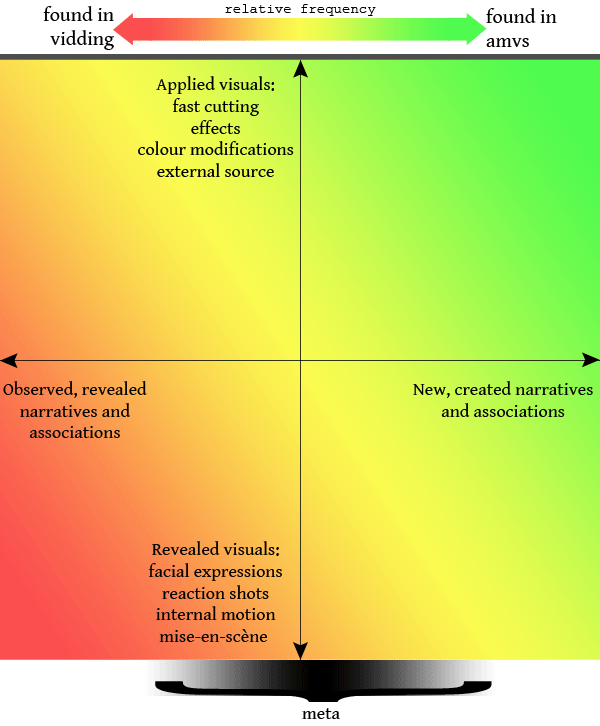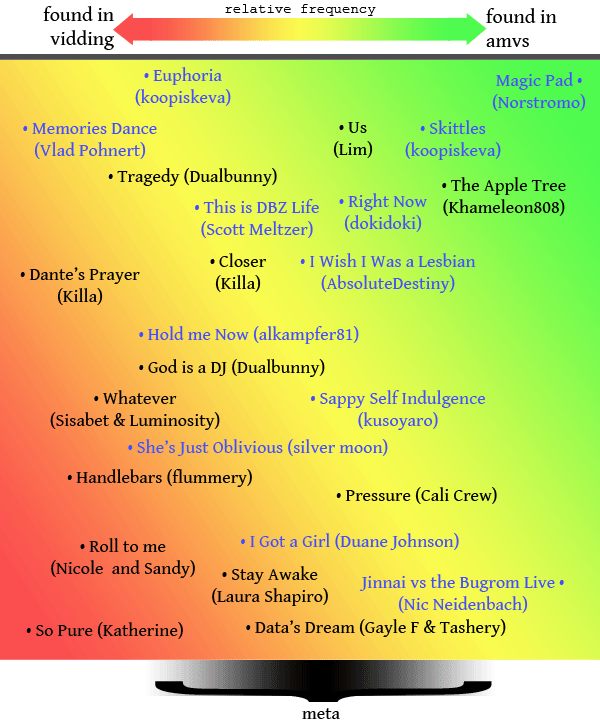DIY Media 2010: Anime Music Videos (Part Three)
/This is the fourth in an ongoing series of curated selections of DIY Video prepared in relation to the screening of DIY Video 2010 at the Hammer Museum in Los Angeles and organized by Mimi Ito, Steve Anderson, and the good folks at the Institute for Multimedia Literacy. The following is an interview with Tim Park from AnimeMusicVideos.org in which he responds to my questions about the anime fan scene.
Many get confused by the superficial resemblances between Fan Vids and Anime Music Vids. Though both are expressions of fan appreciation, they come from very different traditions. How would you describe the similarities and differences between the two?
For this question, I asked AbsoluteDestiny, who started making AMVs in 2001, and switched to making vids in 2005. He's much more familiar with the vidding community than I am, but also has familiarity with the AMV community in order to compare. He wrote:
Henry's question is a really huge one and one I've actually given a lot of thought. There was a time, in the 2vcr days of both vidding and amvs, where there were a lot of similarities between the videos made in the two communities. Hair by Media Cannibals is largely the same vid as Hair by You Know Who, albeit with different gender gazes. As the communities, skills and aesthetics developed, the respective videos started to diverge. The reasons for this are a mixture of three important factors:
1) How the source is read and enjoyed
2) How the source lends itself to video editing techniques
3) What kinds of videos the communities give praise (and reward) to
In very very broad terms, the vidding community grew out of media fandom's more narrative side, fan-fiction and so on, with a strong emphasis on character over genre. Anime fandom, on the other hand, is largely interested in genre, spectacle, Japanese culture and self-referentiality. These differing priorities tend to different subjects for videos - Wonder of Birds (Laura Shapiro) versus AMV Hell (Zarxrax) to take two extremes.
Then we have the very nature of the source. Scenes in anime are not emotionally subtle - visually, especially in TV anime. Much of the emotional nuance is carried by the voice acting and only the more emphasised visual emotions (joy, anger, embarrassment) remain when the footage is removed from its audio. So where vidding can rely on the superbly nuanced body language of the actors, anime can really only pull on whatever aesthetic flourish the source gave them (flowers, blushing, thought bubbles with super-deformed characters beating each other up etc). To do subtle emotion with anime is hard and it's not unknown to rely on external manipulation (such as Playground Love by Nathan Bezner). Thankfully, animation lends itself to external manipulation very well and roto-scoping the footage and puppeteering it to do your bidding is not out of the realm of possibility, which allows for original narratives that are still very much in the spirit of anime (with its genre, spectacle, culture and meta fixations).
Lastly we have the community and how their reception of the works develop and refine aesthetics. The AMV community learned to walk at conventions and even in the early days of Anime Expo and Otakon a formal structure for AMV exposition was created in the form of the contest. Categorisation and the need to find ways to compare highly subjective works led to the formation of AMV genres and a fond regard for technical proficiency (being something that is much more objective when judging a video's quality). While the explosive growth of the community towards the mid 2000s did introduce all kinds of new aesthetics, the major genre categorisation and the search for technical wonders moved amv work further to the side of original spectacle, sometimes very disconnected from the narratives of the sources being used. Ultimately, however, it is a combination of all three elements here that have created the communities we have and the output they produce.
There are wonderful oddities and outliers on both sides but the kinds of work you are likely to find largely fit into the following spectrum:

Vidding tends toward deep analysis of character and show and utilisation of interior movement where amvs tend toward meta, spectacle and genre works with a strong utilisation of external motion, footage, effects and original art.
I've also vaguely plotted some well-known videos (though the amvs totally show my age) onto the graph. It's very rough but this should give an idea as to how I see the whole amv vs vidding spectrum.
[Titles in black are vids, titles in blue are AMVs]

Your account of AMV focuses on their American origins. Are such vids part of the Otaku tradition in Japan or is this a distinctly western response to Anime? If the former, what kinds of contact exists between the artists in the two countries? If the later, is the AMV being picked up by Japanese fans as well?
Learning about hobbyist video editing by fans in Japan and sharing ideas is difficult due to the language barrier. Remix videos in Japan that we're familiar with are called MADs, since one of the early tapes was labelled "Kichigai Tape", or "Tape of Madness". There are many different types of MADs, but early on the AMV community was exposed to a number of Seishiga MADs (and to many, "MAD" came to be a term with only this narrow definition), where still images, often from dating games or visual novels, have motion and other effects applied to them. This creates a distinct aesthetic that was emulated by some North American AMV creators such as VicBond007 in his Believe AMV.
In 2005, one MAD editor named pianos (interview from 2004) came to Anime Weekend Atlanta with a translator, and showed the audience MADs made by him and other editors at his panel. Some of them can be difficult to understand, again due to the language barrier, but there was one short MAD I came across years ago that I liked so much, I remade it for an English-speaking audience.
It used to be fairly difficult to find MADs. I stumbled across some videos where the files were split up between hosts to avoid bandwidth and space limitations. Later on, I came across a collection of them on Usenet. Now you can find Japanese fan videos on Nico Nico Douga, but of course it's a Japanese site so it can be difficult to navigate. Some of them get uploaded to YouTube so you can see them there. They can be hard to find since MAD is a common English word, but you can try searching for "Nico Nico MAD" to find some examples. Several MADs consist of anime-inspired custom artwork, which is relatively rare in AMVs. (Some exceptions: Greed vs. Envy, Utena Daioh, Woolongs For Nothing)
What functions do AMV play within the fan community? Are they primarily consumed by existing fans of the program or are they part of the process of educating American fans about Japanese media content?
A little of both. As I wrote in the first segment, fans at AMV panels at conventions have often indicated that they've bought anime after seeing it in an AMV. For those that are already fans of a particular show, today's search engines make it easy to find an AMV that uses that show.
Now, however, the internet also makes it much easier to find both licensed and unlicensed copies of anime, so I have a feeling that the promotional impact of the hobby is now less than it used to be. Though in some cases, editors seek out shows that haven't been licensed here yet, possibly in order to be the first to use a high-quality new title.
What kinds of relationship exists between the AMV creators and the commercial and semi-commercial groups who are marketing anime in this country?
Views on the hobby depend on which company representative you talk to. I heard of one anime convention panel with ADV Films where one of their employees told Brad DeMoss that they loved his Evangelion/Star Wars Episode I parody. The company, while it existed, was also AMV-friendly in other ways, with employees helping to judge at Iron Editor events. Also, for the final DVD of their release of the Noir series, they contacted four AMV editors, including myself, to create videos to include as Easter eggs on the disc. This took some wrangling on their part with the rights holders in Japan, and due to rights issues we were only allowed to use the opening and ending songs from the show, but it was a pretty cool thing of them to do.
On the other hand, reportedly at the closing ceremonies of Anime Expo one year, a Japanese guest of honour was upset when they played an AMV that incorporated one of his works. I'm not sure who the guest was, but AX stopped playing AMVs at their closing ceremonies after that.
For one final example, Anime Tourist reported on a 2002 interview done with Hiroyuki Yamaga, Co-Founder of Gainax and his friend Takami Akai.
Audience question: What is your opinion on anime music videos from a company standpoint and from a personal standpoint? Have you seen any anime music videos?
Mr. Yamaga: What exactly do you mean?
AQ: Like the anime music videos that we are going to be showing tonight?
Mr. Yamaga: I like them a lot. I think that they are very well done.
Mr. Akai: I didn't know that they existed. I actually like them personally.
Mr. Yamaga: I feel that copyrighting is only for professionals. For people who are doing it for their own enjoyment as a hobby, I feel that the line is very blurry. The reason that copyright laws are so strict is because it is very difficult to make the distinction whether or not someone is professional or amateur. But as Gainax, they got their start doing similar stuff so it's very hard for them to say, "No, We won't allow that'. They also feel that they don't really want to say that. As Gainax, the corporation, they have to say, 'No, we haven't seen it', 'Nope, haven't heard about it'. That is how they deal with it.
I've also heard this "willful ignorance" position from some in the North American industry. (again, from a professional standpoint) Though I've heard of at least one employee calling them a "headache", AMVs and the North American anime industry seem to coexist reasonably peacefully.
Tim Park programs videogames by day, and helps to administrate AnimeMusicVideos.org at night. The site has been online for over ten years and catalogs over 100,000 AMVs. He's edited a few dozen AMVs (and one vid) under the name Doki Doki Productions.

